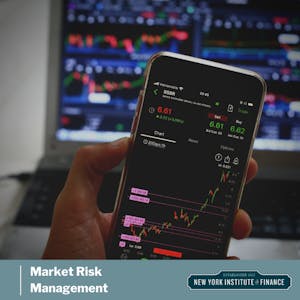Market Risk Management Frameworks & Strategies
This course provides the foundation for understanding the frameworks used to develop market risk management strategies. You will identify the market risks associated with each type of financial instrument. You will be introduced to techniques for estimating the risk associated with each class of investments. By the end of the course, you will be able to select the most effective derivatives for managing risk of a single asset and a portfolio of assets, develop asset selection strategies for managing risk in a portfolio, and model risk associated with a single asset and a portfolio of assets. Learners will complete a project covering the estimation and analysis of risk in a globally diversified equity portfolio. The portfolio will include allocations of equity indexes from the U.S., Japan, Hong Kong, and Germany. Data for the two years prior to March 2020 will be used to convert daily returns in each indexes’ currency into dollar returns. Value-at-Risk and Expected Shortfall for the portfolio will be calculated using an equal-weighted sample and an exponentially weighted sample. Learners will then be given a new 2-year data set that includes the market data through August of 2020. They will be asked to re-evaluate risk for the portfolio using Value-at-Risk and Expected Shortfall.
Identify best-practice frameworks for assessing market risk.
Estimate Value at Risk and use in a risk management strategy.
Model market factors such as interest rates, equity, and commodity prices.
Syllabus
Syllabus - What you will learn from this course
Week 1
Getting Started
Week 2
Module 01: Financial Instruments
This course provides the foundation for understanding the frameworks used to develop market risk management strategies. You will identify the market risks associated with each type of financial instrument. You will be introduced to techniques for estimating the risk associated with each class of investments. By the end of the course, you will be able to select the most effective derivatives for managing risk of a single asset and a portfolio of assets, develop asset selection strategies for managing risk in a portfolio, and model risk associated with a single asset and a portfolio of assets.
Week 3
Module 02: Measuring and Analyzing Market Risk
In module one we’ll look at the different types of financial instruments that are the source of market risk. We’ll first look at bonds and then at equities and lastly, we’ll explore derivatives.
Week 4
Module 03: Managing and Modeling Market Risk
Now that we’ve had a complete look at different financial instruments and derivatives take a look at measuring and analyzing market risk first from the perspective of probabilistic measures and then second from the perspective of statistical measures.
Week 5
Course Project
Week 6
End of Course
FAQ
When will I have access to the lectures and assignments?
Access to lectures and assignments depends on your type of enrollment. If you take a course in audit mode, you will be able to see most course materials for free. To access graded assignments and to earn a Certificate, you will need to purchase the Certificate experience, during or after your audit. If you don't see the audit option:
What will I get if I subscribe to this Specialization?
When you enroll in the course, you get access to all of the courses in the Specialization, and you earn a certificate when you complete the work. Your electronic Certificate will be added to your Accomplishments page - from there, you can print your Certificate or add it to your LinkedIn profile. If you only want to read and view the course content, you can audit the course for free.
Is financial aid available?
Yes. In select learning programs, you can apply for financial aid or a scholarship if you can’t afford the enrollment fee. If fin aid or scholarship is available for your learning program selection, you’ll find a link to apply on the description page.
Reviews
Awesome course!! This will look good on the resume and help secure a better job for me.
Very good course to understand the different ways of measuring and managing Market risk.
